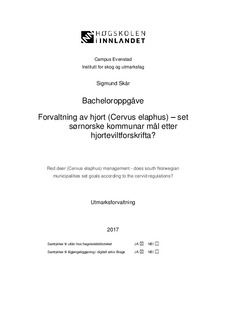| dc.contributor.author | Skår, Sigmund | |
| dc.date.accessioned | 2017-06-23T08:44:56Z | |
| dc.date.available | 2017-06-23T08:44:56Z | |
| dc.date.issued | 2017 | |
| dc.identifier.uri | http://hdl.handle.net/11250/2446768 | |
| dc.description.abstract | Hjorten (Cervus elaphus) i Europa og Noreg har auka i tal og spreidd seg etter andre verdskrig. I Noreg er det vestlandet som er kjerneområdet for hjort, og det er der tettleiken er høgast. Nyleg har hjorten ekspandert sørover, austover og nordover. Hjortejakt er ei viktig kjelde til rekreasjon og økonomi, noko som set auka krav til ei god forvaltning.
Hjorteviltforskrifta set føringar for kommunar si forvaltning av hjort. Kommunar skal setja mål for korleis dei skal forvalte hjorteviltet, dei skal setja mål for mellom anna bestandsutvikling, beiteskadar og viltpåkøyrslar. Måla skal vera presise og målbare, noko som er viktig for at måla skal gå ann å forvalte etter.
Eg har valt ut 100 tilfeldige kommunar i Sør-Noreg for å finne ut korleis det står til med målsetjingane. Kommunane vart kontakta via e-post, med førespurnad om å få tilsendt målsetjingane deira.
Mine resultat viser at mange av kommunane som har svart, har målsetjingar for hjorteforvaltninga, men det er relativt store manglar når det kjem til mål for beiteskadar og mål for å få ned viltpåkøyrslar. Det viste seg ogso at kommunar med store minsteareal per hjorteløyve, i mindre grad set mål for å unngå viltpåkøyrslar. Samstundes har mange kommunar upresise mål, noko som gjer at dei er vanskelege å ta omsyn til, og forvalte etter.
I oppgåva argumenterer eg for at det i tillegg til forskrifta burde vorte utarbeida ein standard for korleis kommunane kan lage gode mål. For å lage gode mål må ein ha god kunnskap om viltet, bestandsdynamikk, beite og påkøyrsle i kommunen. Det kan og vera lurt å introdusera og forklara korleis eit målhierarki fungerer i praksis. | nb_NO |
| dc.description.abstract | The red deer (Cervus elaphus) in Europe and Norway has both grown in number and expanded their distribution after World War II. In Norway, the density is at the highest at the west coast, but from there the red deer has expanded to the south, the east and the north. Red deer is an important source to both recreation and economy.
The cervid regulations set demands to municipalities for red deer management. The municipalities have to set goals for the red deer management. The goals should include wanted population development, limits of accepted forest damage and also regard red deer traffic accidents. It is important that the goals are precise, to make it easier to manage the goals.
I have chosen 100 random municipalities in the South of Norway. The municipalities were contacted by e-mail, where I asked for their management goals.
The results show that many of the municipalities that answered my e-mail have goals for the red deer management. But a lot of the municipalities lack goals for forest damage and goals for red deer traffic accidents. It also shows that municipalities with larger minimum area pr. red deer license have less goals regarding red deer traffic accidents. Many of the municipalities also lack accurate goals, and the goals are hard to manage.
In this paper, I argue that in addition to the cervid regulations, there should be worked out a standard that makes it easier for the municipalities to make goals that are easier to manage. If you want to make good goals, you need knowledge about the red deer population dynamics, their use of the forest, and the traffic accidents conflict. In this standard it may be a good idea to also introduce how the goal hierarchy work in practice. | nb_NO |
| dc.language.iso | nno | nb_NO |
| dc.title | Forvaltning av hjort (Cervus elaphus) – set sørnorske kommunar mål etter hjorteviltforskrifta? | nb_NO |
| dc.title.alternative | Red deer (Cervus elaphus) management - does south Norwegian municipalities set goals according to the cervid regulations? | nb_NO |
| dc.type | Bachelor thesis | nb_NO |
| dc.subject.nsi | VDP::Matematikk og Naturvitenskap: 400::Zoologiske og botaniske fag: 480 | nb_NO |
